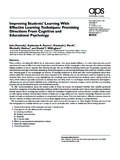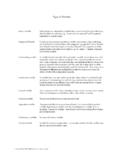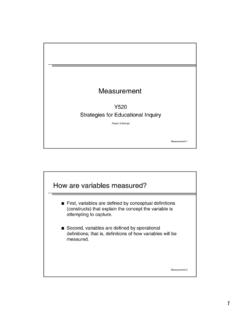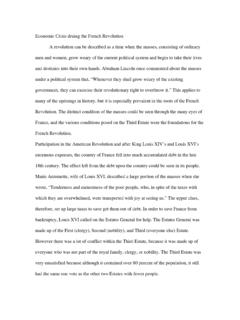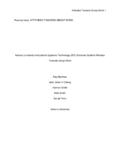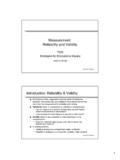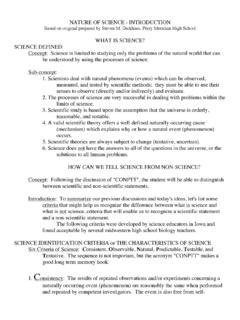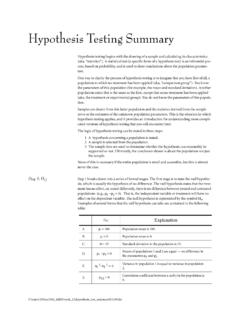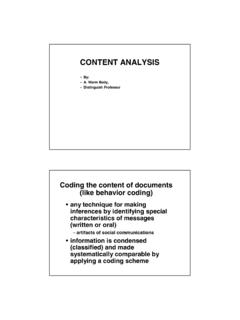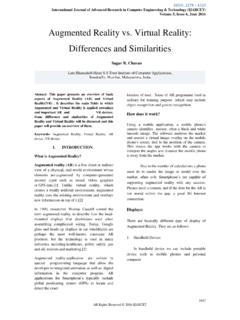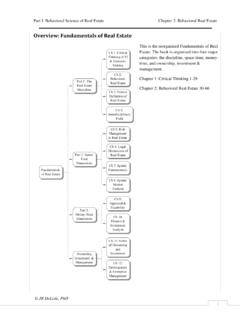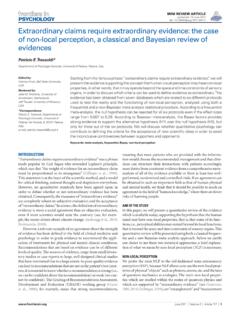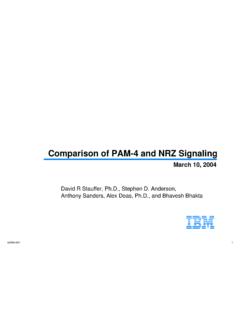Transcription of Measuring the MBTI And Coming Up Short
1 *David J. Pittenger is assistant professor and Chair of the Department of Psychology atMarietta College. He has written extensively in his field, and has received a Teaching ExcellenceAward, Early Career from Division Two of the American Psychological Pittenger earned his in psychology from the University of Georgia, his from TexasA&M University, and his from the College of the Coming Up Shortby David J. Pittenger*Some research has shown that the Myers-Briggs Type Indicatortest doesn't really measure what it purports to measure.
2 The author,too, has his reservations as to its reliability and a test that would allow you to predict the type of career for which a person is best suited For example,Mary comes to you for career counseling. She presents you with her education and work history, and an outline ofher career objectives. Specifically, she says that she would like to find an entry-level position where she can helppeople, and is interested in a career in the social then administer a personality inventory. The scores suggest to you that Mary is a logical person who isachievement oriented, quick to identify flaws in others, and values truth over tact in herself and others.
3 Based onthese observations, you conclude that Mary may not be well suited for work that requires empathy for others' feelingsand tolerance for ambiguity. Instead, you suggest to Mary that her strong points are tile ability to focus her attentionupon objective information and to make rational decisions. You then advise Mary to consider alternative careers thatmatch her education, abilities, values, and claim that such a test is available with the Myers-Briggs Type Indicator (MBTI).1 Recently, Paul D. Tiegerand Barbara Barron-Tieger described how the MBTI can be used by career counselors to help clients find jobs forwhich they are best suited and with which they will be most Indeed, they claim that understanding aperson's type is one of the most important factors to consider when helping that person make career decisions.
4 TheTiegers also provide a brief summary of the MBTI test and review how it can be used in job MBTI is a very popular test of personality. Each year millions of copies of the test are administered in theworkplace, schools, churches, community groups, management workshops, and counseling centers. Many peoplesee the MBTI as an invaluable tool that helps them understand their own behavior as well as the behavior of spite of the popularity of the MBTI, there are many problems with its use. There is a large body of research thatsuggests that the claims made about the MBTI cannot be supported.
5 In other words, although the MBTI appearsto measure something, many psychologists are not convinced that any significant conclusions can be based on thetest. In this article I will review the basic research that questions the validity of the Brief History of the MBTIThe MBTI was developed by Isabel Briggs Myers and her mother, Katherine Briggs. Katherine Briggs becameinterested in type theory after reading Carl Jung's book, Psychological Type. Isabel Briggs Myers shared her mother'sinterest in type theory and began to create the MBTI in the early l940s as a test to be used for personnel believed that different occupations favored different personality orientations, and that Jung's theory provideda theoretical link between personality and job 1957, the Educational Testing Service (ETS) began to distribute the MBTI for research purposes.
6 ETS spentconsiderable time and resources in deciding whether the MBTI should have been adopted as a part of its vast libraryof proprietary tests. After an unfavorable internal review of the test, ETS chose not to pursue the furtherdevelopment and ended its relationship with In 1975, Consulting Psychologists Press acquired the right tosell the MBTI. Since then, the test has been successfully marketed to an extremely wide test is now available to licensed counselors and psychologists, to college instructors and personnel who havehad graduate training in the theory of testing, and to individuals who have completed Short courses on theadministration and interpretation of the MBTI.
7 There are currently many professional organizations that support thestudy of type. The Journal of Psychological Type is a scholarly periodical that publishes original research and reviewsof research on type theory. There are also several professional organizations for individuals who use the MBTI asa part of their work. The Center for Applications of Psychological Type provides training on the administration andinterpretation of the test, offers scoring services, and maintains a data base of MBTI profiles. The Association ofPsychological Type (APT) represents the interests of professionals who use the MBTI.
8 The APT also providesworkshops that quality non-psychologists to purchase and administer the MBTI in nonclinical Brief Theory of TypeThe primary feature of the theory behind the MBTI is that each person's personality fits into only one of 16 categories are based on four features of personality, each consisting of two opposite preferences. Accordingto the theory, all people have an innate preference that determines how they will behave in all situations. The fourdimensions are:5 Extroversion (E) vs Introversion (I). This dimension reflects the perceptual orientation of the individual.
9 Extrovertsare said to react to immediate and objective conditions in the environment. Introverts, however, look inward to theirinternal and subjective reactions to their (S) vs Intuition (N). People with a sensing preference rely on that which can be perceived and are consideredto be oriented toward that which is real. People with an intuitive preference rely more on their nonobjective andunconscious perceptual (T) vs Feeling (F). A preference for thinking indicates the use of logic and rational processes to makedeductions and decide upon action.
10 Feeling represents a preference to make decisions that are based on subjectiveprocesses that include emotional reactions to (J) vs Perception (P). The judgrnent-perception preferences were invented by Briggs and Myers to indicateif rational or irrational judgments are dominant when a person is interacting with the environment. The judgmentalperson uses a combination of thinking and feelings when making decision, whereas the perception person uses thesensing and intuition the MBTI is a theory of types, a person can have only one preference. Although it is possible for people todevelop the complimentary style (an introvert, for example, could learn to be more extroverted when speaking ingroups) the primary preference will always dominate the person's personality.
